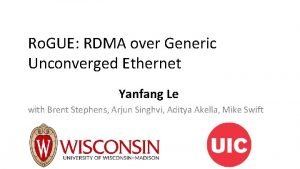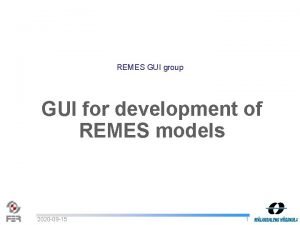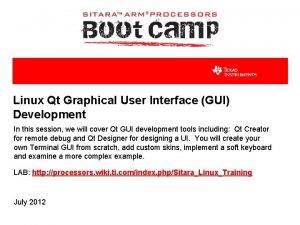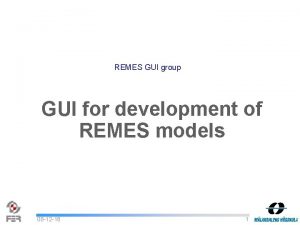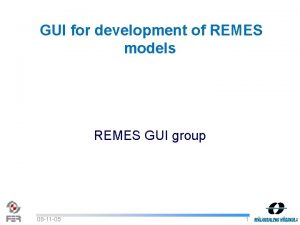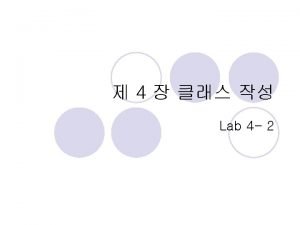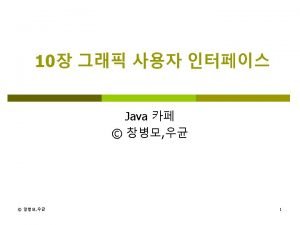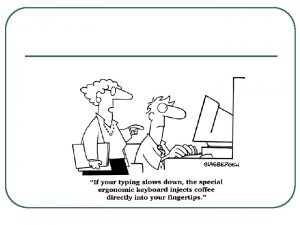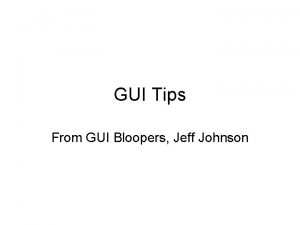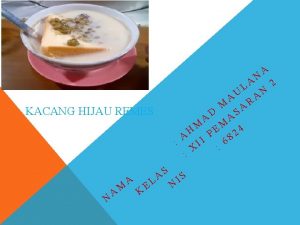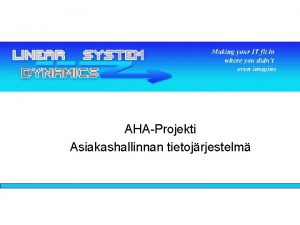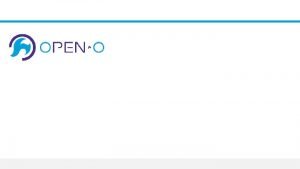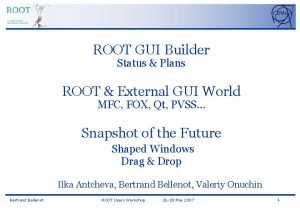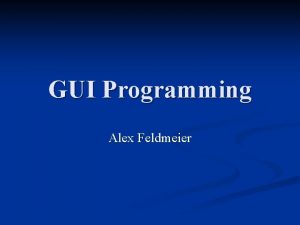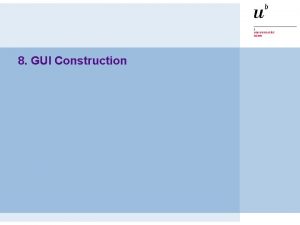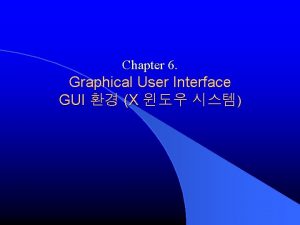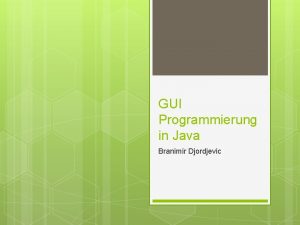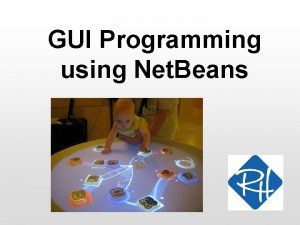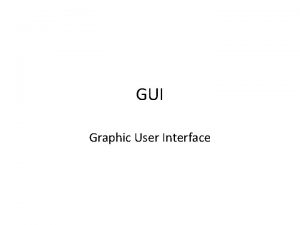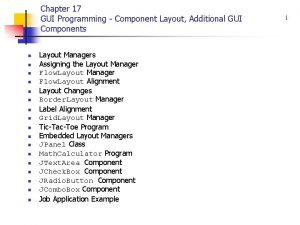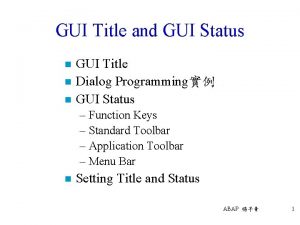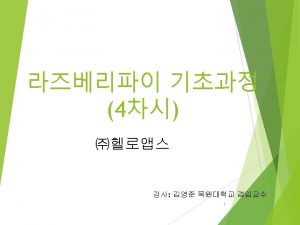REMES GUI group GUI for development of REMES




























- Slides: 28

REMES GUI group GUI for development of REMES models 2020 -09 -15 1

Content • • • Work summary Experiences Requirements Design Demonstration 2020 -09 -15 2

Work hours summary • Aprox. 1200 hours working hours spent • Average 170 hours person • Average 16 hours a week person 140 120 100 80 60 40 20 0 W 45 W 46 W 47 2020 -09 -15 W 48 W 49 W 50 W 51 W 52 W 01 W 02 W 03 3

Financial summary Planned cost 189000 SEK Actual cost 234500 SEK • Our actual project cost went over initial planned project budget 2020 -09 -15 4

Activity timeline Activity W 44 W 45 W 46 W 47 W 48 W 49 W 50 W 51 W 01 Team organization Requirements gathering Project design Implementation Testing and debugging Documentation Finalized product Final presentation Planned activity finish Actual activity 2020 -09 -15 5 W 02 W 03

Requirements • • • Planned requirements Added requirements Fulfilled Partially fulfilled Dropped or Unnecessary 2020 -09 -15 28 1 26 2 1 6

Communication (1/2) • Skype • Google groups • SVN : ) • Meetings live • Voice chat ( just once) date 7

Communication (2/2) • Using google groups to arrange skype meeting • No fixed meeting time, mostly in evening and late night ( especialy if deadline is next day) • Problems in communication; not techinacal but social, lots of time needed to explain oneselves ( cultural differences) date 8

What are our experiences? • Working in a distributed project – Positive • Valuable experience with teamwork • The team had good discussions without major conflicts • Interesting to experience working with other cultures – Negative • It is sometimes quite hard • Distributed communication is complicated due to delays 2020 -09 -15 9

What were our experiences? • Planning – Difficult in the beginning when knowledge was limited • PM did not receive access to course website the first week – Causes of deviations • Some members had exams of other courses – During this days the global working hours decreased so much • Christmas Vacations – Owing to this the development stop a little 2020 -09 -15 10

What are our experiences? • Work division and synchronization – Has functioned well although because of problems of communication sometimes there were some little problems – Integration throughout the implementation phase in the development of the transformation application 2020 -09 -15 11

What would we change? – At the end we are happy about our work but not always was so: • We decided to show our slides to Aneta one day before the presentation • We arranged to separate the work according to our skills 2020 -09 -15 12

Fundamental requirements (1) • Graphical Editor – Add mode – Add connectors – Switch between views • Show timing view • Show functional view • Show resource usage view – Open a submode in a new window 90%

Fundamental requirements (2) • Project explorer – Create new project – Open existing project – Merge projects – Save project – Display a tree of project elements in hierarchical order: • Be able to select element of a project • Delete selected element • View attributes of selected element

Fundamental requirements (3) • Palette – Select an element in the editor window – Add point to a mode – Add connection to a mode • Add init point • Add exit point • Add entry point – Add conditional connector

Fundamental requirements (4) • Attribute editor – View selected elements properties – Edit selected elements properties

Other requirements • All connections must satisfy REMES model • File structure and storing – XML Metadata Interchange (XMI) • XMI-files for storing model info. (connectors, values, resource, time etc. ) • Eclipse plug-in (Desirable, not req. ) • Based on GMF (Desirable, not req. )

Design process

Design (1) • Model view of REMES editor

Design (2) • Metamodel

Technologies (1) • Java • EMF (Eclipse Modeling Framework) – Java framework – Code generation facility for building tools and applications based on structured model – Rapidly turns models into efficient, correct and easily customizable Java code • EMF uses XMI (XML Metadata Interchange) as input

Technologies (2) • GEF (Graphical Editing Framework) – Enables developers to easily create rich and consistent graphical editors within Eclipse • GMF (Graphical Modeling Framework) – Provides infrastructure for developing graphical editors based on EMF and GEF – Produces graphical editing surface for any domain model in EMF

Testing process (1) • Metamodel – MMUnit derives test model from the test specification – Metamodel is automatically checked for every derived test model

Testing process (2) • Use-case scenario testing

Demonstration 1 2020 -09 -15 25

Demonstration 2 2020 -09 -15 26

DEMONSTRATION 2020 -09 -15 27

Thanks for all the success Our group is thankful to 1. Steering Group for encouragement 2. Our supervisors for guidance 3. Other course partcipents sharing knowledge 2020 -09 -15 28
 Ge gi gue gui güe güi
Ge gi gue gui güe güi Gui group
Gui group Linux gui development tools
Linux gui development tools Iso 22301 utbildning
Iso 22301 utbildning Typiska drag för en novell
Typiska drag för en novell Tack för att ni lyssnade bild
Tack för att ni lyssnade bild Ekologiskt fotavtryck
Ekologiskt fotavtryck Varför kallas perioden 1918-1939 för mellankrigstiden
Varför kallas perioden 1918-1939 för mellankrigstiden En lathund för arbete med kontinuitetshantering
En lathund för arbete med kontinuitetshantering Underlag för särskild löneskatt på pensionskostnader
Underlag för särskild löneskatt på pensionskostnader Tidbok för yrkesförare
Tidbok för yrkesförare Sura för anatom
Sura för anatom Densitet vatten
Densitet vatten Datorkunskap för nybörjare
Datorkunskap för nybörjare Tack för att ni lyssnade bild
Tack för att ni lyssnade bild Debatt mall
Debatt mall Delegerande ledarstil
Delegerande ledarstil Nyckelkompetenser för livslångt lärande
Nyckelkompetenser för livslångt lärande Påbyggnader för flakfordon
Påbyggnader för flakfordon Arkimedes princip formel
Arkimedes princip formel Svenskt ramverk för digital samverkan
Svenskt ramverk för digital samverkan Jag har nigit för nymånens skära
Jag har nigit för nymånens skära Presentera för publik crossboss
Presentera för publik crossboss Teckenspråk minoritetsspråk argument
Teckenspråk minoritetsspråk argument Kanaans land
Kanaans land Treserva lathund
Treserva lathund Fimbrietratt
Fimbrietratt Claes martinsson
Claes martinsson Cks
Cks
